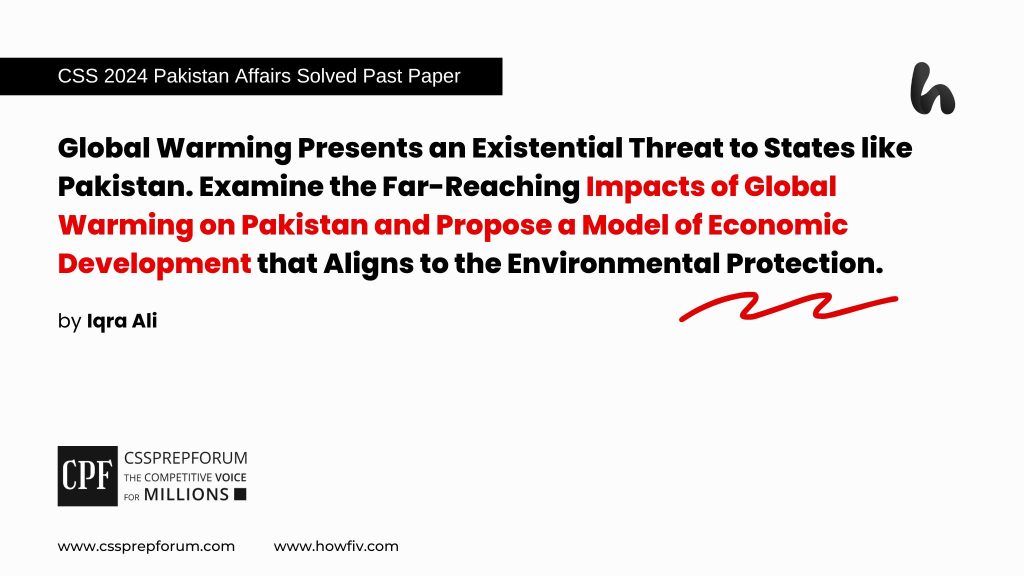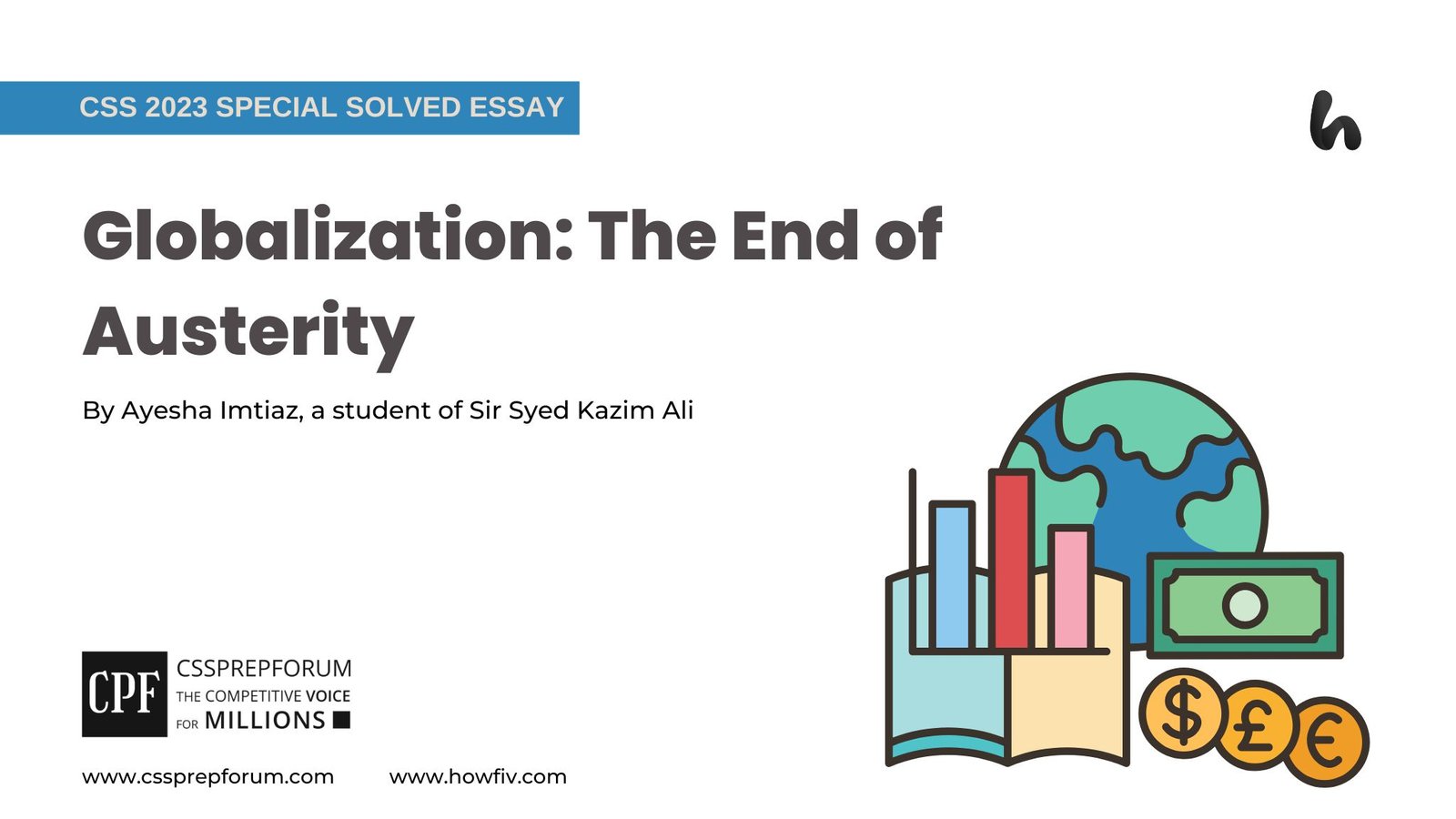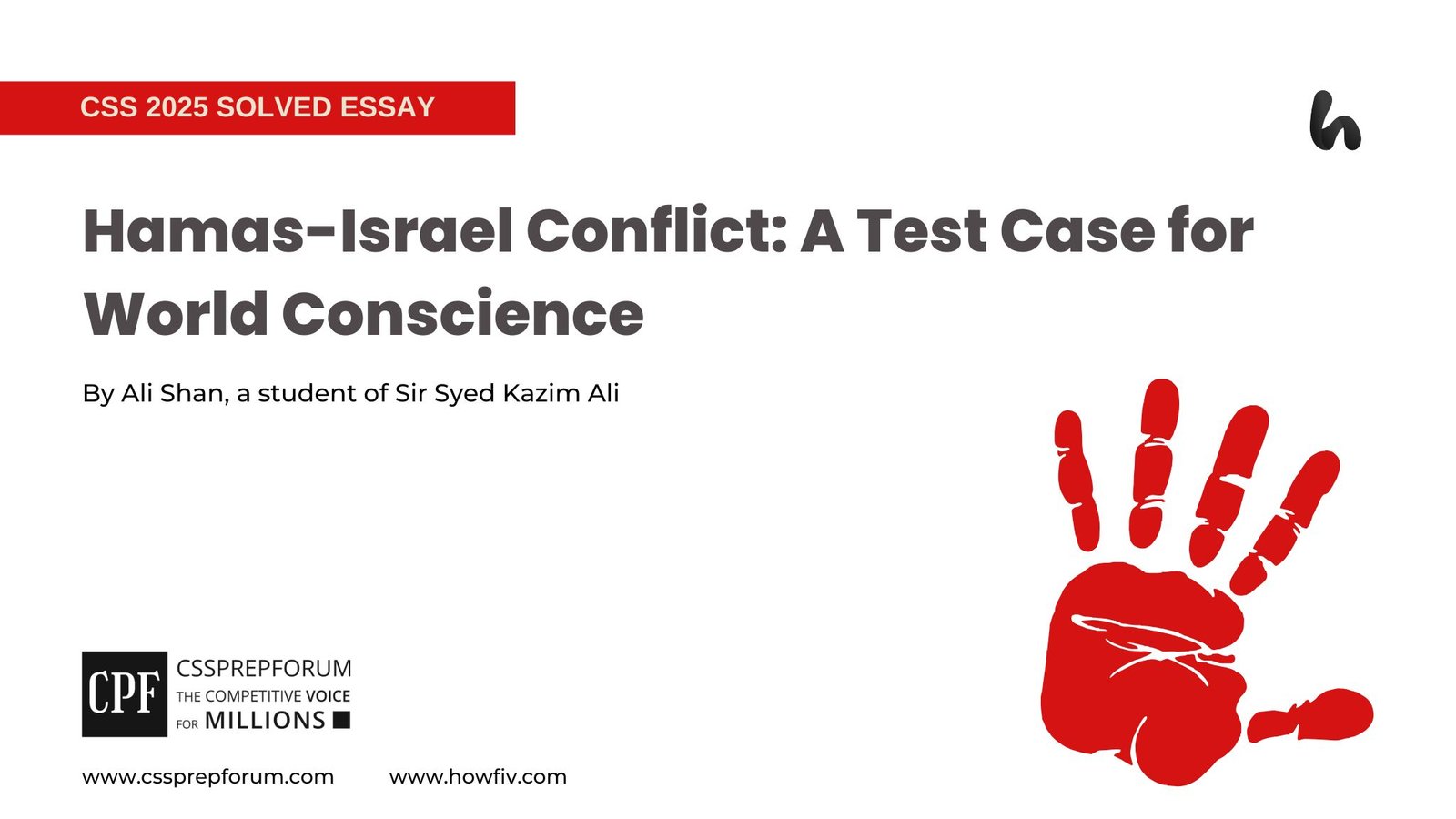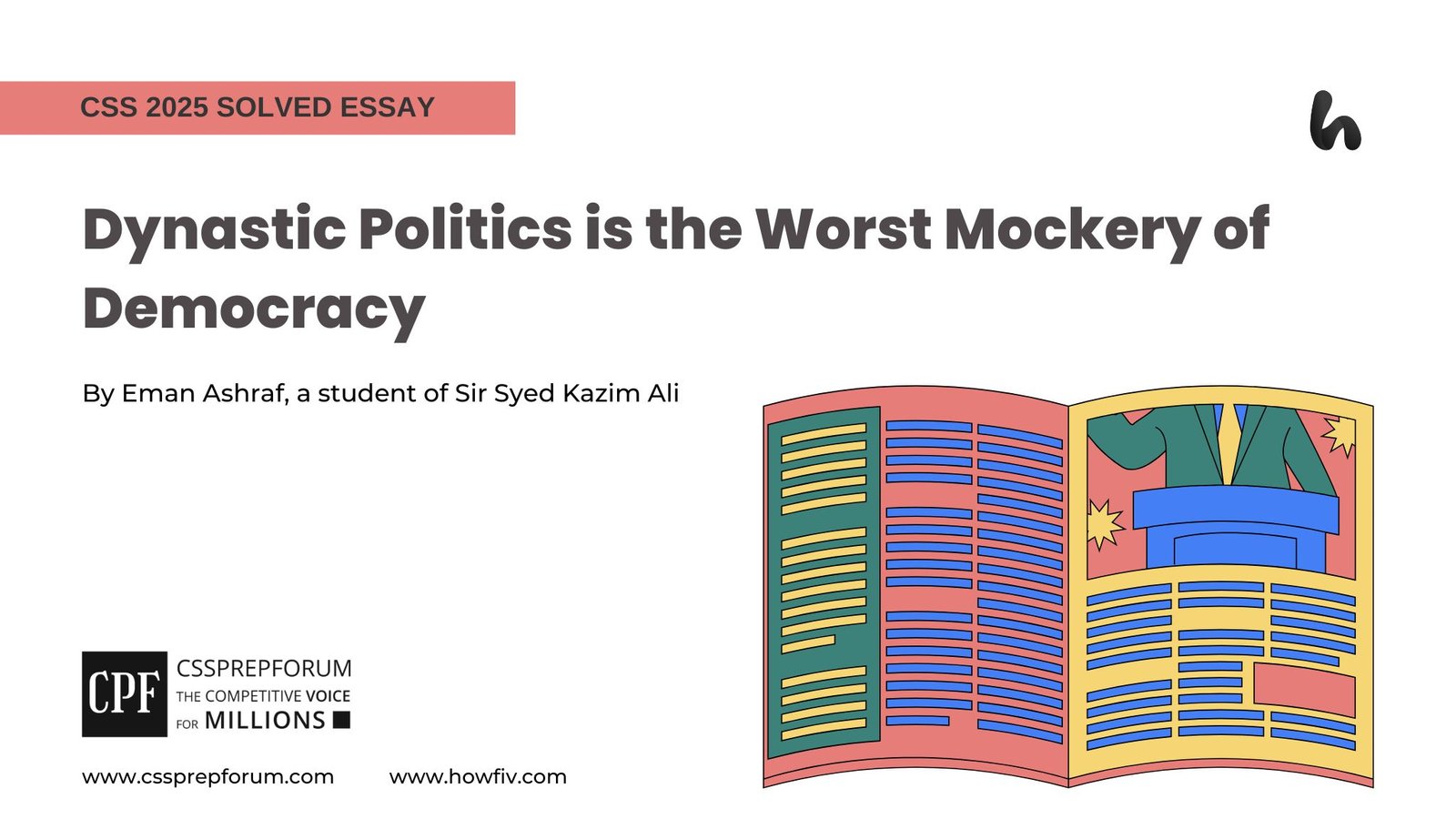CSS 2024 Solved Pakistan Affairs Past Papers | Global Warming and Pakistan
The following question of CSS Pakistan Affairs 2024 is solved by Miss Iqra Ali, Pakistan’s Best Pakistan Affairs Coach, on the guided pattern of Sir Syed Kazim Ali, which he taught to his students, scoring the highest marks in compulsory subjects for years. This solved past paper question is uploaded to help aspirants understand how to crack a topic or question, how to write relevantly, what coherence is, and how to include and connect ideas, opinions, and suggestions to score the maximum.

Question Breakdown
In this question, the examiner has asked you two things: first, about the far-reaching impacts of global warming on Pakistan, and second, he asked you to propose a model of economic development that aligns with environmental protection. So, first, you need to briefly introduce the things that are going to be a part of your answer with historical background about the reason and impacts of global warming on the country. Then, write your answers by splitting them into parts as the question demands. Finally, end your answer with a critical analysis and conclusion. The following solved question provides a comprehensive answer covering all the main aspects. However, as far as the answer in the paper is concerned, limit yourself to 3 or 4 leading arguments against each part of the question.
Outline
1- Introduction
2- Understanding the Reasons of Global Warming with the Special Reference to the Geographic Location of Pakistan
3- What are the Impacts of Global warming on Pakistan?
3.1- Environmental Impacts
- ✓Droughts, Land Degradation, and Recurrent Floods
- ✓Melting of Glaciers
- ✓Heat Waves and Rise in the Sea Level
3.2- Social Impacts
- ✓On the Food Security of Pakistan
- ✓On the Water Security of Pakistan
- ✓On the Security of Human Lives
3.3- Economic Impacts
- ✓On the already Faltering Economy, GDP Growth, Cost for Rehabilitation and Infrastructure Development
- ✓Financial Loses and Fiscal adjustments
- ✓ Inflation and Poverty
4- A Model of Economic Development that Aligns to the Environmental Protection
4.1- ✓ Integration of Sustainability Goals into Policy Frameworks: ‘Environmental Protection Goals’
4.1.1- Large-Scale Integration and Implementation of Green Initiatives, and Inclusive Growth Strategies Would Promote Economic Growth and Protect the Environment Side-by-Side
- ✓Investments in Renewable Energy
- ✓ Energy-Efficient Technologies
- ✓Climate Resilient and Sustainable Infrastructure
- ✓Afforestation and New dams for Water Reservation
4.1.2- Environmental Regulations and Resource Management Would Promote Economic Growth and Protect the Environment Side-by-Side
- ✓ Sustainable use of Natural Resources
- ✓ Protect the Ecosystem by reducing Plastic leakage
- ✓Sustainable Agriculture and Forestry Practices
- ✓Establishment of Protected Areas
- ✓Carbon Pricing and Environmental Taxes to Incentivize Businesses to Adopt Sustainable Practices
5- Conclusion

Answer to the Question
Introduction
In the 21st century, the surging global warming is one of the gravest challenges confronting human beings, the environment, and the world economies around the globe. According to the UN report, Climate scientists warn that the world needs to limit the warming to 1.5 degrees Celsius (2.7 degrees Fahrenheit). The world is on track for around 2.5 degrees Celsius of warming. Unfortunately, the under-developing third-world countries are more prone to its calamitous impacts. Historically, Pakistan has remained grappling with the disastrous implications of global warming-induced climate change, such as droughts, land degradation, recurrent floods, melting of glaciers, heat waves, sea level rise, and increased frequency of cyclones. In addition, it has subjected the country to a greater risk of vulnerability, such as food insecurity, water insecurity, and loss of human lives due to climate-induced catastrophes. However, its hazardous consequences have impacted the already faltering economy in an unprecedented way by decreasing the overall growth of GDP, causing acute financial losses, and increasing the demand for a large fiscal balance for rehabilitation and infrastructure development. As a result, poverty, inflation, and poor service delivery marred the economic and social growth by subjecting them to myriad crises. Hence, it is high time to design a model that pragmatically aligns with environmental protection. A model that integrates the sustainability goals in policy frameworks, such as green initiatives, inclusive growth strategies, and stringent environmental regulations, and encourages resource management that can promote economic growth and protect the environment side-by-side. To conclude, a National Plan of Action is indispensable to implement these strategies to the extent that it can meet the targeted goals.
Understanding the Reasons of the Global Warming with the Special Reference to Geographic Location of Pakistan
Global warming is an extreme weather condition characterized by a gradual increase in the Earth’s average temperature. However, the reasons are the emissions of greenhouse gases alongside carbon dioxide, Methane, and other air pollutants. According to international and national environmental scientists, unfortunately, Pakistan is among the top 20 countries most affected by climate change. The country is highly vulnerable to the impacts of climate change because of its geographic location in South Asia. The irreversible effects of global warming may cause devastating natural disasters, which are an alarming threat to people’s lives around the globe. First, it causes the melting of glaciers, polar ice, and ice sheets, and even drought. According to a report, in many regions of Pakistan, the temperature exceeded 122°F (50°C), so Gilgit Baltistan and KP are the most vulnerable to the negative impacts of Global warming because of the presence of glaciers. Second, a rise in sea level due to heavier rains causes floods. In 2022, the country was hit hard by massive floods during monsoon season, which affected almost two-thirds of the country’s districts. Third, from pollution to overpopulation, 75 per cent of climate change is caused by human activities. However, the nation appears to be a recipient of natural calamities despite being the least instigator of global warming, as Pakistan contributes considerably less than 1% of Global greenhouse gas emissions. To learn from the past, a National Action Plan is needed of the hour at federal and provincial levels for building resilience to Global warming. However, the plan may include mitigation, adaptation, and capacity building to combat the hazardous impacts of Global warming.
What are the Impacts of Global warming on Pakistan?
A- Environmental Impacts
The country contributes very little to the overall emissions of greenhouse gases. Unfortunately, it remained one of the most severely hit countries in the world. According to the United Nations Framework Convention on Climate Change (UNFCC), Pakistan, although only contributing 0.9% to global greenhouse gas (GHG) emissions, is one of the most vulnerable countries to the impacts of climate change. The following are the recurrent environmental, social, and economic impacts on the country of the climate change.
- ✓Droughts, Land Degradation, and Recurrent Floods
First, the country has been hit hard by massive and deadly floods. Although every year, the floods hit badly the country, the floods of 2022, 2010, and 2011 have emerged as the most catastrophic in the country’s history. Second, the continuous spell of drought, particularly in the provinces of Baluchistan and Sindh, has reduced the river flow and dried up the irrigation canals. The problem of land degradation due to these changes has added fuel to the crisis. Third, the increasing tropical activity in the Arabian Sea in 2001, 2004, 2007, 2010, and 2011 has put the country’s metropolis city, Karachi, at an increased risk of being hit by cyclones. Fourth, the annual average temperatures have been increasing. According to the United Nations Framework Convention on Climate Change (UNFCC), in the southern half of the country, the mean temperature of the coastal areas rises from 0.6-1°C along with an increase in solar radiation from 0.5-0.7°C.
- ✓Melting of Glaciers, Heat Waves and Rise in the Sea Level
Next, recurrent heat waves in the country due to increased average temperatures subject the country to an absurd crisis. According to a report, cloud cover has a 3-5% decrease and sunshine hours of the days are increasing in central Pakistan. However, the heat wave in Sindh in 2010 broke all the records with the recorded temperature of 53.5 °C, the hottest temperature ever recorded in Asia. In addition, the rising temperatures, as a result, have caused the melting of glaciers and resulted in a gradual increase in the sea level. According to the Karachi Tidal Station, an increase has been recorded in the mean sea level at a rate of 1.1 mm/yr during the past 100 years.
B- Social Impacts
- ✓On the Food Security of Pakistan
The social impacts of global warming-induced climate change include food insecurity, water insecurity, human lives insecurity, and destruction of infrastructure. First, food insecurity has increased hunger across the marginalized regions of the country. The under-developed areas of all the provinces faced unprecedented crises, such as wheat and grain shortages. However, the reason behind this increasing food insecurity lies in recurring droughts and floods, which led to a drastic decrease in agricultural output. According to a report, the farmers of Khyber Pakhtun Khawa reported a 50% reduction in crop yield due to droughts. However, the floods of 2022 have destroyed 71% of the standing rice crop, 59% of the vegetable crop, and 45% of the maize crop in the country.
- ✓On the Water Security and Human Lives
Second, due to scorching heat waves, floods, and other natural disasters, a large number of people die every year. Next, the perceptible water insecurity has put the country’s fate in the abyss. According to the United Nations Development Program (UNDP report), rising temperatures, increasing saltwater intrusion in coastal areas, a growing threat of glacier lake outburst floods, more intense rainfall, and changes in monsoon and winter rainfall patterns are just some of how climate change is expected to affect the hydrologic resources of the country.
c- Economic Impacts
- ✓On the already Faltering Economy, GDP Growth, Cost for Rehabilitation and Infrastructure Development
In addition, the dire impacts of global warming on the already faltering economy marred the country’s stability, such as a decrease in the overall GDP growth, unprecedented financial losses, poverty, and inflation. According to the United Nations Development Program (UNDP), climate change cost the country $ 14 billion in 2022, which is 5% of its GDP.
- ✓Financial Loses, Fiscal adjustments, Poverty, and Inflation
The unprecedented financial losses, poverty, and inflation have marred the country’s stability. According to the United Nations Development Program (UNDP), climate change cost the country $ 14 billion in 2022, which is 5% of its GDP. Next, the inflation due to the floods of 2022. According to the World Bank report, Inflation in Pakistan reached around 23 per cent in FY23, reflecting flood-related disruptions to the supply of food and other goods, higher energy prices, and difficult external conditions, including tighter global monetary conditions.
A Model of Economic Development That Aligns to the Environmental Protection
The government can design a model of economic development that aligns with environmental protection, such as by integrating the sustainability goals into the national fiscal policy framework. However, the national development plans must incorporate practices that can increase the potential for the success of these development goals. To assess the progress, the sustainability indicators must be integrated at the national level. In addition, the sectoral policies can be aligned with the sustainability objectives.
- ✓Large-Scale Integration and Implementation of Green Initiatives, and Inclusive Growth Strategies would Promote Economic Growth and Protect the Environment Side-by-Side
First, the large-scale integration and implementation of green initiatives and inclusive growth strategies would promote economic growth and protect the environment side-by-side. It can be done by following the steps, such as investing in renewable energy, energy-efficient technologies, climate-resilient and sustainable infrastructure, afforestation, and new dams for water reservation. It can also decrease the country’s dependence on oil to meet energy requirements, and the capital used to buy the oil can be used in social development. In turn, it will foster economic growth and sustainability.

- ✓Environmental Regulations and Resource Management would Promote Economic Growth and Protect the Environment Side-by-Side
Second, strict environmental regulations and resource management would promote economic growth and protect the environment. It can be done by sustainable use of natural resources, protecting the ecosystem by reducing plastic leakage, incorporating sustainable agriculture and forestry practices, establishing protected areas, and by carbon pricing and environmental taxes to incentivize businesses to adopt sustainable practices.
Conclusion
Pakistan has faced multifaceted destruction from natural calamities. It includes high-frequency earthquakes, massive floods, and extreme weather conditions. However, these disasters have caused human lives loss, infrastructure damage, and large-scale displacements of the affected people. These calamities have hampered economic growth and posed a threat to the country’s stability. In an already faltering economy, the cost of rehabilitation and huge spending to mitigate the after-effects of climate change are not easy to manage. However, aid and debt only cover a part of the solution to climate-induced issues, whereas it has hit the economy to the depth of its roots, leading to a social crisis. Thus, a fiscal model that promotes economic development while maintaining environmental protection is indispensable. In a nutshell, environmentally friendly practices protect the environment and also decrease the nation’s dependency on others.
CSS 2024 Solved Pakistan Affairs
CSS Solved Past Papers’ Essays
Looking for the last ten years of CSS and PMS Solved Essays and want to know how Sir Kazim’s students write and score the highest marks in the essays’ papers? Then, click on the CSS Solved Essays to start reading them.
CSS Solved Essays
CSS Solved General Science & Ability Past Papers
Want to read the last ten years’ General Science & Ability Solved Past Papers to learn how to attempt them and to score high? Let’s click on the link below to read them all freely. All past papers have been solved by Pakistan’s top CSS GSA coach having the highest score of their students.
General Science & Ability Solved Past Papers











